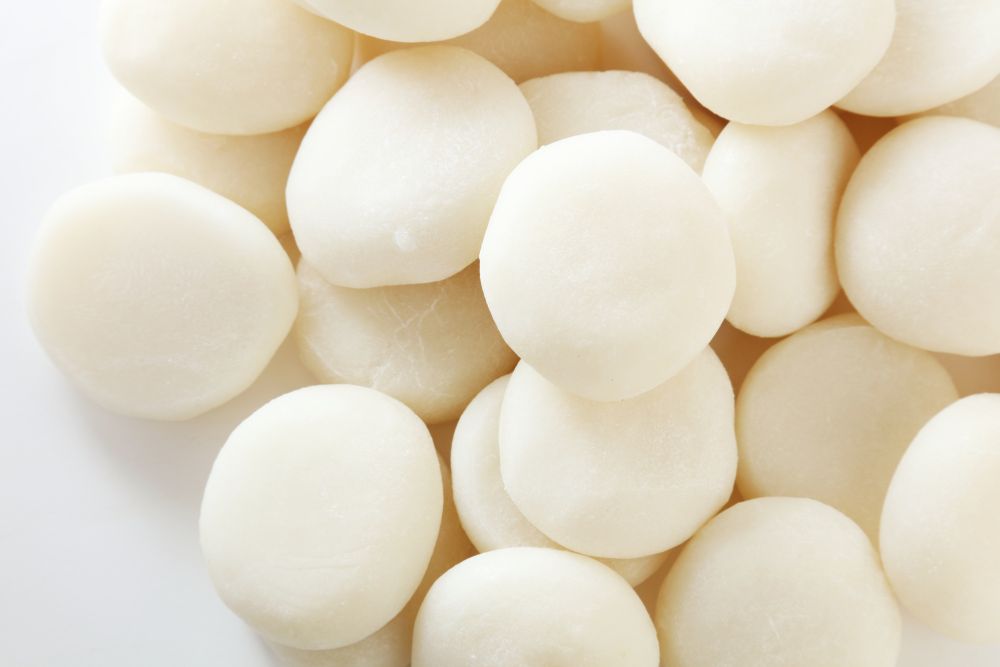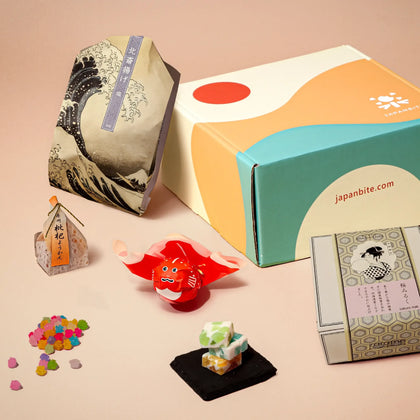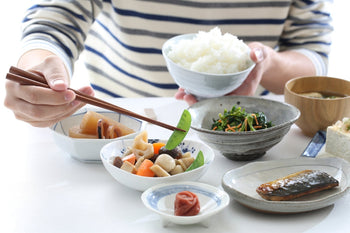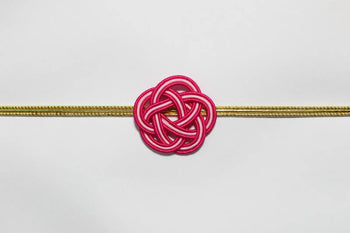

Soft and pillowy, mochi are becoming more and more popular all over the globe, but did you know that they actually originate from ancient rituals? Let's discover the fascinating world of Japanese rice cakes, starting from traditional tastes to modern interpretations, and take a bite of their deep cultural significance.
What is mochi
Literal meaning
Mochi, or omochi (where "o" is an honorific prefix) is made by steaming glutinous rice in a mortar until it becomes sticky and shaping it into a moderate size. Also known as “rice cake”, this food has been handed down in Japan since ancient times and is characterized by its unique stretchy texture, which swells when baked and melts when boiled.
Cultural meaning
Since ancient times, mochi has been passed down to the present day as a food eaten on auspicious days such as New Year's holidays, festivals, and seasonal events. In fact, mochi was originally considered a sacred food and was often offered to gods as well; it was believed that eating rice cakes would give strength and spiritual power to generate new life, and the custom of consuming them on celebration days spread rapidly.During January, the New Year's month, you will have the opportunity to see kagami mochi, which consists of two round and flat rice cakes placed on top of the other one. Kagami mochi has a double meaning: in the first place, it is an offering to the "god of the year"; in addition, it is eaten on January 11 every year in the hope of a disease-free life. It is considered ominous to point a knife at an offering, so kagami mochi is broken by a mallet; since the word "split" is also not auspicious, the term "opening the mochi" is preferred.
Types of mochi
Sakura mochi
Sakura mochi is a sweet named after cherry blossoms, consisting of a mochi confectionery wrapped in cherry leaves.
There are two types of this treat: one was invented in the Kanto region and is mainly eaten in eastern Japan, while the other one has been produced in the Kansai region and spread throughout the entire country. Even though both are usually called "sakura mochi", when it is necessary to distinguish one from the other, the first ones are called "Chomeiji", while the latter ones are called "Dōmyoji".
Sakura mochi is a confectionery that can be eaten all year round, but as the name suggests, it is colored pink to represent cherry blossoms and is mainly consumed during Hina Matsuri (an annual festival in Japan that prays for the healthy growth of young girls, celebrated on March 3).
Dango
Dango is made by adding water to grain flour and rolling it into dumplings, then steaming or boiling them. There is an incredible number of dango variations: some are sprinkled with soybean flour, while others are seasoned with soy sauce or red bean paste.
As for the difference between dumplings and mochi, the first ones are made starting from flour, while mochi production starts after steaming the grains.
You can easily buy dango at convenience stores and supermarkets at low prices! If you want to learn more about Japanese dumplings, we recommend you read this article .
Warabi mochi
Warabi mochi is a traditional confectionery made by adding water or sugar to buckwheat flour, mixing it while heating, and cooling it to harden it.
Buckwheat flour is made from the starch contained in the roots of bracken: it takes a lot of time to produce it, and the amount that can be obtained is very small, so it is very rare and valuable; for this reason, inexpensive products that can be bought at convenience stores and supermarkets use tapioca flour instead of buckwheat.
The texture of warabi mochi is smooth and jelly-like. It contains many nutrients such as vitamin B, vitamin E, carotene, and fiber: it is nutritious but healthy, making it an easy sweet to eat while on a diet.

Daifuku mochi
Daifuku mochi, or simply daifuku, is a Japanese sweet made of red beans wrapped in rice cake. The mochi is made very finely, and the amount of bean paste is often equal to or even greater than the amount of rice cake! Starting from the classic red bean daifuku to variations such as strawberry daifuku, this confectionery is extremely popular among people of all ages.
It is said that daifuku derives from uzura mochi (a quail-shaped treat sold in Kyoto), which was first produced in the early Edo period: after miniaturizing it and adding sugar to the bean paste, Japanese confectioners obtained the sweet we know today.
Mochi ice cream
Consisting of ice cream wrapped in mochi (as the name suggests!), this modern interpretation has rapidly spread in the Western world: nowadays, we can find mochi ice cream of all flavors, like vanilla, chocolate, and strawberry. We cannot forget to mention the product that started this trend, “Yukimi daifuku”, which was produced by Lotte in 1981.
Habutae mochi
Habutae mochi is the main representant of Fukui Prefecture's confectionery culture. It is made by steaming glutinous rice flour and kneading it with starch syrup and sugar. When you put it in your mouth, it melts softly and rapidly spreads a gentle, elegant sweetness.
"Habutae" is a high-quality silk cloth that is known for being very pleasant to the touch: in Fukui Prefecture, the production of silk fabrics began in earnest around the beginning of the XIX century, and by the beginning of the 20th century, this region accounted for 60% of the nation's export value. A confectionery shop called Matsuokaken was created to express the texture of habutae with Japanese sweets, and this is how habutae mochi was invented.
Kashiwa mochi
Kashiwa mochi is a flat, round rice cake made of kamishin flour, folded in half with bean paste in between, and wrapped in Quercus dentata or Smilax china leaves.
Since these leaves do not fall off until new shoots grow, it is said that they have the auspiciousness of "prosperity of descendants (uninterrupted family lineage)"; this treat is therefore often eaten on a festivity: May 5 is a national holiday called "Children's Day", which is considered the correspondent for boys of Hinamatsuri.

Seasonal mochi
In Japan, many seasonal sweets are produced and sold: it is a way to enjoy different climates, natural motifs, and flavors even more. Even though mochi itself can be eaten all year round, we can appreciate a wide variety of season-related rice cakes.
"Bota mochi" in Spring
The peony flowers (called "botan" in Japanese) that bloom in spring give the name “bota mochi” to this delicious treat. This mochi is made by steaming glutinous rice, rolling it lightly so that rice grains remain, and then sprinkling it with bean paste. It is often eaten during the week when the spring equinox occurs.
"Minazuki" in Summer
It consists of a confectionery made by placing red beans on a white uiro dough and cutting it into triangles. In Kyoto, it is customary to eat it on June 30, when people purify themselves from mistakes committed in the first half of the year and celebrate the latter half yet to come. Strictly speaking, uiro can be distinguished from mochi: they have the same ingredients, but uiro is steamed instead of being pounded.
"Ohagi" in Autumn
Ohagi is made by mixing glutinous and nonglutinous rice, lightly dipping and rolling the mixture up, and wrapping it in sesame, bean paste, etc. Its name derives from the fact that the shape of azuki beans resembles the flower of hagi (bush clovers), one of the seven autumn herbs. This sweet is often eaten on the autumn equinox day.

"Yuzu mochi" in Winter
This rice cake is made from yuzu, a citrus plant known for its strong, unique flavor. Yuzu mochi is not only delicious: its pretty appearance is also a reason why this confectionery is that popular.
Regional varieties
Mochi has played an extremely important role in Japanese culinary culture since ancient times, and it has never stopped evolving. Even today, the shape of rice cakes changes depending on where we are; we can say the boundary is around Sekigahara in Gifu Prefecture: the regions at the east of it usually have square-shaped mochi, while the prefectures at the west of this city generally make round mochi. In fact, Japanese rice cakes originally had a round shape. There are various theories about the origin of squared mochi; according to the most accredited one, during the Edo period, a method of cutting flattened mochi was created, and this gradually spread because it was easier to transport squared rice cakes.
And now, let us introduce some famous regional mochi!
"Akafuku mochi" from Mie Prefecture
This specialty can be enjoyed near the famous Ise shrine in Mie Prefecture. It is characterized by a smooth bean paste placed on top of the rice cake. Akafuku mochi was made about 300 years ago and is a popular souvenir that represents the Kansai region, with its distinctive box wrapped in pink Japanese paper.

Shiromochi Kuromochi via Akahuku
"Miidera chikara mochi" from Shiga Prefecture
Miidera chikara mochi is an unusual rice cake that is sprinkled with green bean soybean flour and eaten on a skewer. It was developed by a traditional confectionery shop in the XIX Century.
"Umegae mochi" from Fukuoka Prefecture
You can enjoy umegae mochi at a famous shrine called “Dazaifu Tenmangu” in Fukuoka Prefecture. Its name can be translated to "plum branch mochi": this treat is in fact famous for being pierced into a plum branch before being baked.
We can appreciate how mochi has developed uniquely in each region; some of them might not even look like rice cakes at first glance! During your trip to Japan, eating mochi from different prefectures will be an interesting and interesting way to discover local Japanese traditions.
How to enjoy mochi
There are many ways to eat rice cakes, such as baking, frying, and boiling them. In addition, there are endless arrangements of seasoning, so you can eat plenty of mochi without getting bored of its taste! However, it is also important to note that mochi is easy to get stuck in the throat, and accidents occur frequently during the New Year's season when rice cakes are often eaten.
Standard way to eat mochi
The most common way to eat mochi is by buying rice cakes at your local supermarket and molding them in an oven, toaster, or frying pan. You can then dip them in soy sauce and wrap them in seaweed, or sprinkle them with soybean flour or bean paste.
Mochi pounding experience
During your trip to Japan, you might have the opportunity to experience "mochitsuki", which consists of using a big mortar and a pestle to pound glutinous rice. In the past, villages, and families used to cooperate in making mochi at New Year's and other festivities, and even now, this tradition has been handed down as a way to eat freshly made mochi at schools and community events.
Boiled mochi
Mochi is also eaten in soups (called “ozoni”) and hotpots. The smooth texture of boiled rice cake is so different from the one of baked mochi, that it might feel like a completely different ingredient. Recently, instead of cheese, "mochi fondue", which is made by boiling rice cakes and softening them, has become popular.
Mochi as a “secret” ingredient
Whilst mochi is mainly known as a staple food, it is often used as a "secret" ingredient as well. "Mochi kinchaku“ is a popular meal made by wrapping rice cake in fried tofu and is usually eaten together with other simmered foods. In addition, mochi can be broken into small pieces and used as butter: when fried, you can enjoy the unique texture of crispy rice cake!
Recently, more and more arrangement recipes have become popular, including "mochi pizza" and chocolate mochi. Also, a snack called "okaki" made by deep-frying rice cakes is largely appreciated and can be easily found at supermarkets!
Health benefits and nutritional values
Rice cakes contain carbohydrates, fats, and proteins, as well as vitamin B1 and potassium; the latter two help to recover from fatigue and prevent swelling. Mochi is also rich in amylopectin, which has the effect of warming the body, promoting metabolism, and strengthening the immune system.
How to make mochi
Mochi ingredients
Usually, glutinous rice is the main ingredient of mochi, but nonglutinous rice (the one we usually eat) may also be used; a rice cake made by mixing the two is called "kowamochi".
While nonglutinous rice has a translucent aspect, glutinous rice is white and opaque; anyway, the biggest difference is the absence of starch in the latter.
Steps to make mochi
Nowadays, mochi is usually made by machines, but here are the main steps of rice cake making:
Grind the glutinous rice and soak it in plenty of water overnight (12 hours is preferable). After that, put it in a colander and drain the water.
Put the glutinous rice in a steaming cloth spread in a pot above the steamer and make a slight depression in the center; this will speed up the passage of fire.
When it is steamed, pound the glutinous rice for 10 minutes.
Sift some potato starch evenly into a tray (to prevent sticking of the mochi) and place your rice cake there to obtain its final form.
At home, mochi is stored in plastic wrap or even vacuum packaged. The longer it is conserved, the more flavor it loses, but if frozen, rice cake can be stored for several months to a year.
Where to buy mochi
Where to buy mochi when visiting Japan
While exploring Japan, you will be able to buy mochi in local supermarkets and convenience stores at affordable prices. As we saw, there are plenty of ways to enjoy rice cakes, from salty treats to sweet options. If you are seeking seasonal or regional delicacies, we suggest you conduct online research and visit confectionery shops, department stores... or even shrines!
Where to buy mochi in your country
The global popularity of Japanese cuisine has surged, with many items becoming available even in local supermarkets; if you do not find what you were looking for, you can also opt for an Asian store. Yet, exclusive regional, seasonal, and especially authentic delicacies are still difficult to find outside Japan; for these reasons, if you would like to savor mochi, you should consider utilizing online services such as JAPANBITE , which will deliver you a box full of premium traditional confectioneries and green tea every month, ensuring a taste of Japan's essence regardless of your location!




